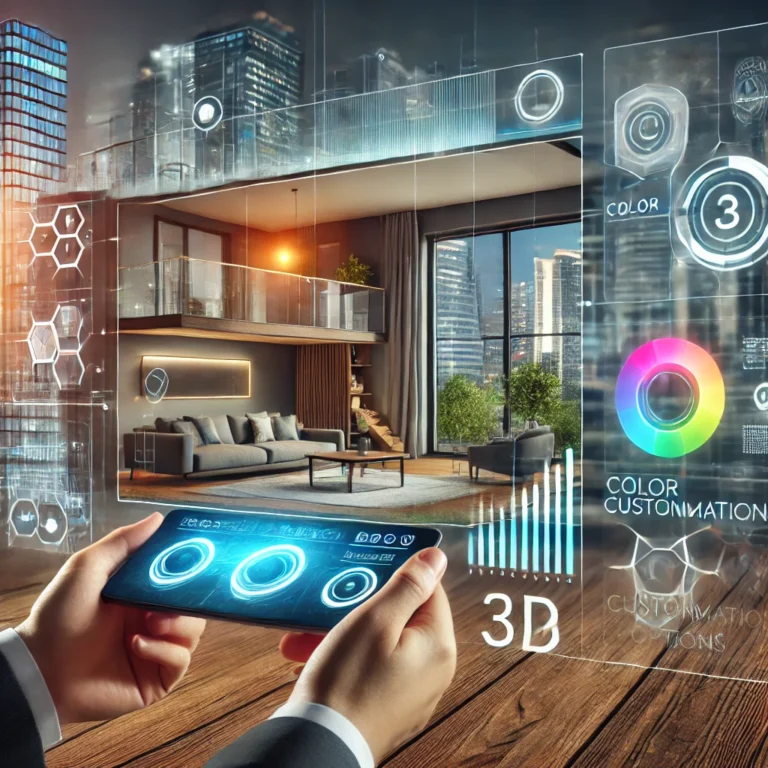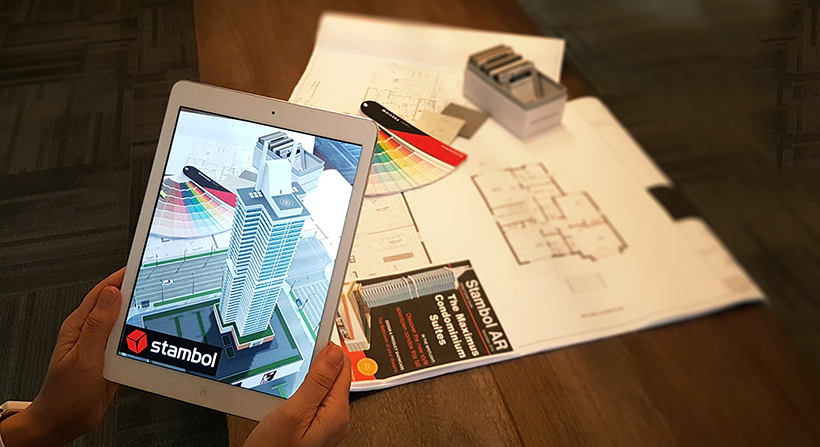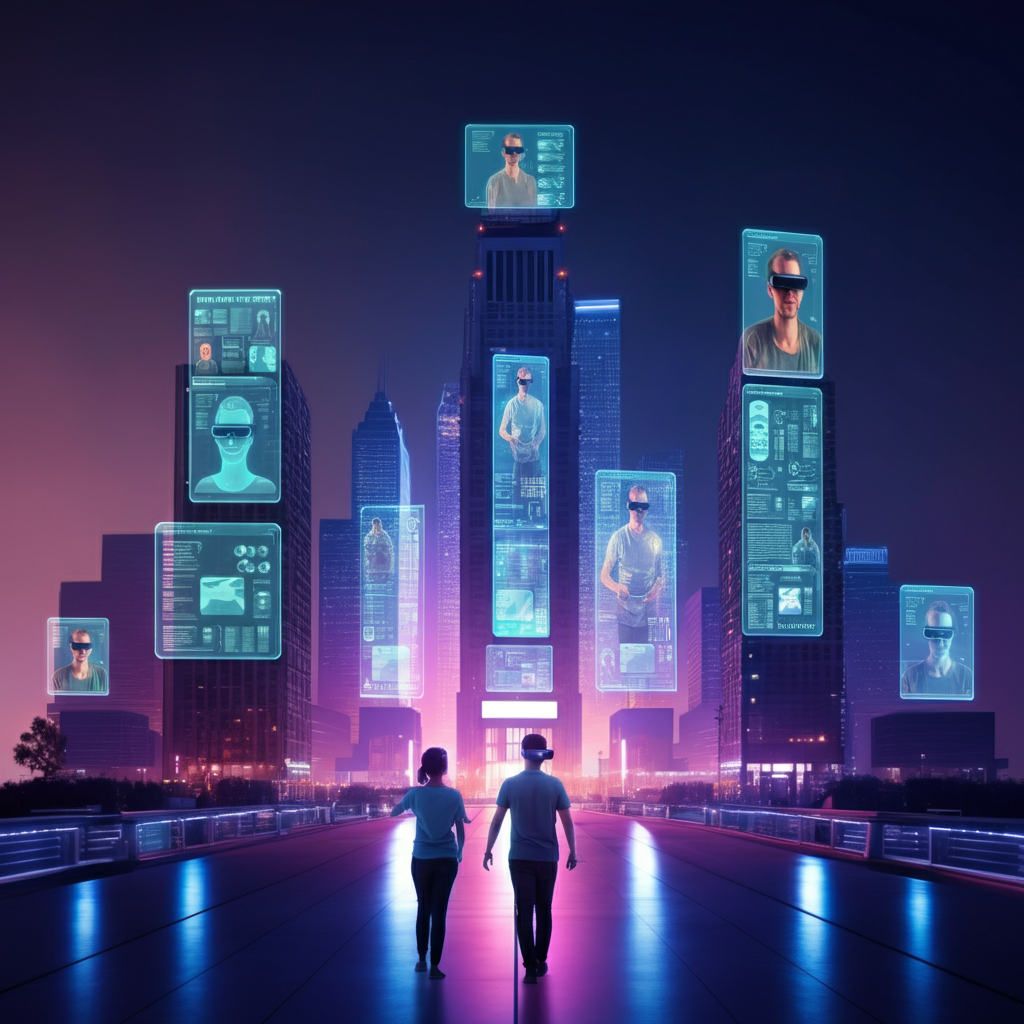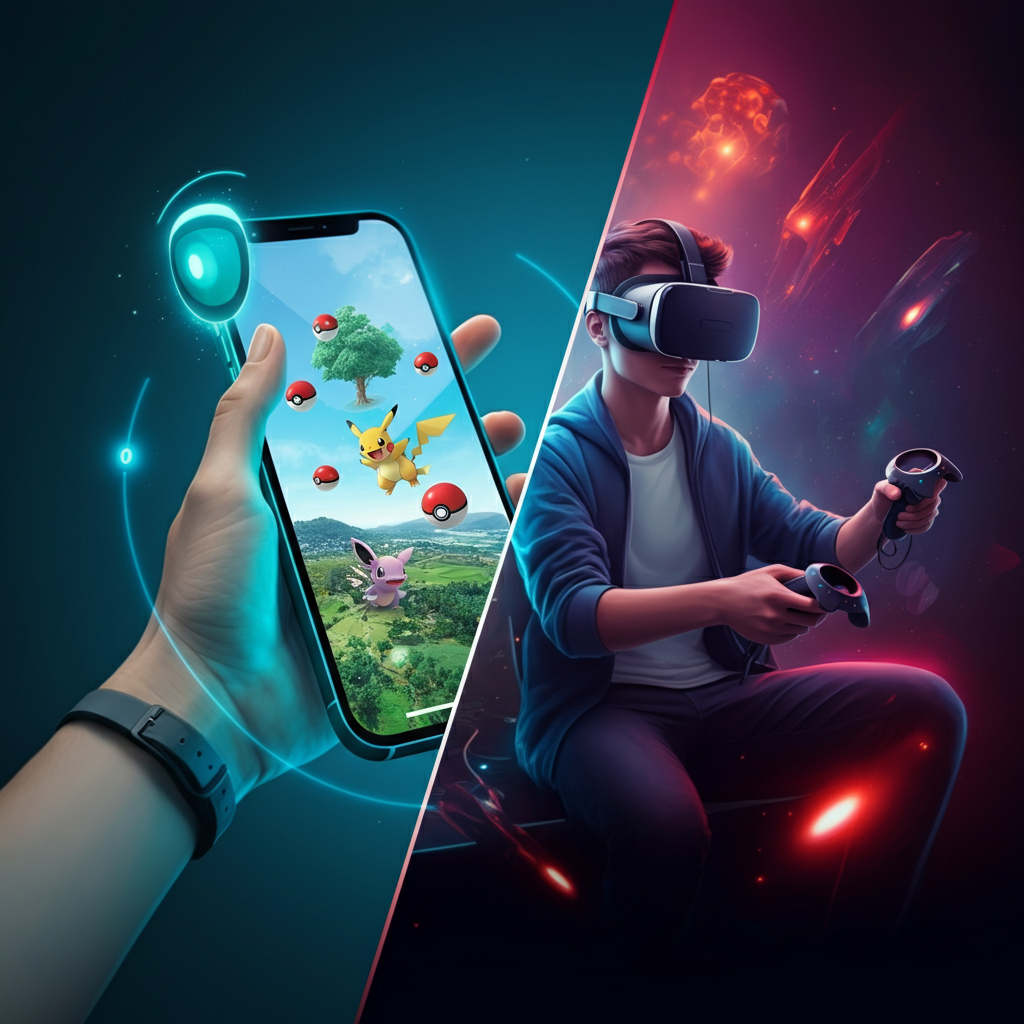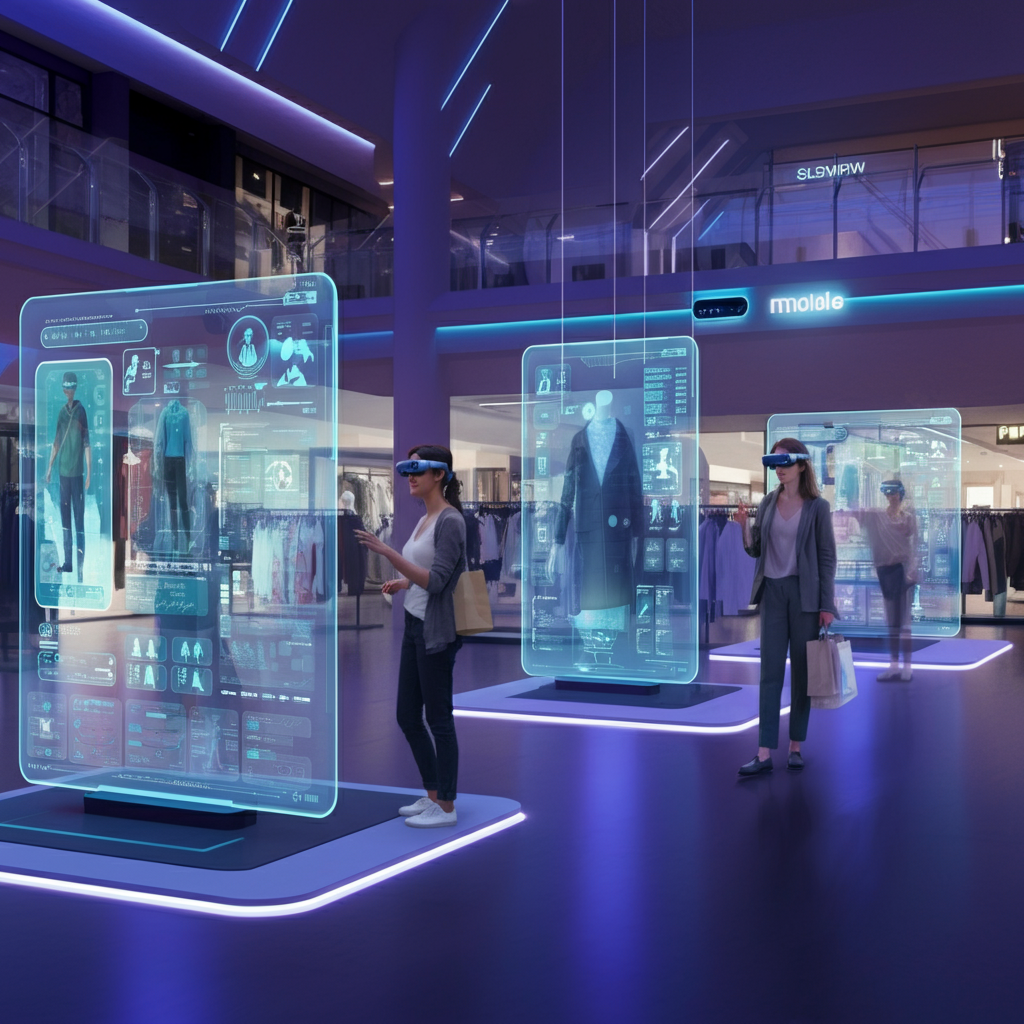AR in Real Estate and Architecture: Augmented Reality (AR) has emerged as a groundbreaking technology that seamlessly blends digital elements with our physical world, creating an enhanced interactive experience through smartphones, tablets, and smart glasses.
As we stand at the intersection of digital innovation and traditional industries, AR has proven itself to be far more than just a novelty – it’s becoming an indispensable tool across various sectors.AR is revolutionizing how companies operate, communicate, and deliver value to their customers in today’s fast-paced business landscape.
While industries from retail to healthcare have embraced this technology, nowhere is its impact more visibly transformative than in real estate and architecture.
The marriage of AR with real estate and architecture reshapes how we envision, design, and interact with spaces.
Gone are the days when potential buyers had to rely solely on static images or struggle to imagine how an empty space could look fully furnished.
Architects no longer need to depend exclusively on traditional blueprints and physical models to convey their vision.
Through AR, stakeholders can experience unbuilt structures in their intended location, visualize different design options in real-time, and confidently make informed decisions.
1. AR in Real Estate
Photo Credit: Stambol
Virtual property tours powered by AR technology have fundamentally transformed the real estate buying experience, offering an immersive and efficient way to explore properties from anywhere in the world.
Through AR-enabled applications, potential buyers can walk through properties virtually, gaining a genuine sense of space and flow that traditional photos and videos cannot provide.
AR-powered virtual tours go beyond basic 360-degree videos by adding interactive elements that enhance the viewing experience.
AR in Real Estate and Architecture is increasing. Prospective buyers can tap on various features within a room to access detailed information about materials, dimensions, and specifications.
They can even visualize different furniture arrangements or color schemes in real time, helping them make more informed decisions about a property’s potential.
This level of interactivity creates a more engaging and informative experience that closely mimics an in-person viewing. Interactive 3D property walkthroughs represent the next evolution in virtual property touring.
These sophisticated AR experiences allow users to move freely through a digitally reconstructed property, offering unprecedented freedom of movement and perspective.
Unlike traditional virtual tours that follow a predetermined path, 3D walkthroughs enable users to explore every corner of a property at their own pace.
They can measure spaces, peek into closets, and even step onto virtual balconies to assess views from their mobile devices or computers. For remote buyers and investors, AR technology has become an invaluable tool significantly reducing the time, cost, and risk associated with property acquisition.
International investors can now conduct thorough property inspections without needing multiple cross-country trips. AR in Real Estate and Architecture is the only solution.
This saves substantial travel expenses and accelerates the decision-making process, allowing investors to act quickly in competitive markets. The benefits extend beyond mere convenience.
AR tools provide remote buyers with detailed, accurate representations of properties, helping them avoid potential surprises that might only become apparent during an in-person visit.
They can assess important factors such as natural light throughout the day, the flow between spaces, and the property’s relationship to its surroundings.
Additionally, AR in Real Estate and Architecture applications often include neighborhood information overlays, giving investors insights into local amenities, property values, and development plans.
The integration of AR in real estate has also proven particularly valuable during times when physical property viewings are challenging or impossible.
The technology ensures business continuity while providing a safe, contactless way to explore properties.
This means conducting multiple virtual showings simultaneously for real estate agents, increasing efficiency, and expanding their reach to a global client base.
The bottom line is that AR has made remote property investment more accessible, efficient, and reliable than ever before, fundamentally changing how people buy and sell real estate across borders.
Enabled Interior Design and Staging
AR-enabled interior design has revolutionized how homeowners and professionals visualize spaces before making design commitments.
Using AR applications on smartphones or tablets, users can instantly experiment with different furniture pieces, wall colors, and decorative elements in their actual space.
This AR in Real Estate and Architecture technology eliminates the guesswork traditionally associated with interior design decisions.
Popular platforms like IKEA Place, Houzz, and Wayfair’s View in Room 3D allow users to place true-to-scale 3D models of furniture in their homes virtually.
These apps consider room dimensions and lighting conditions, providing realistic previews of how items will look in the space.
Additionally, professional AR staging solutions help real estate agents transform empty properties into beautifully furnished showcases without the cost and effort of physical staging.
Property Visualization and Blueprint Projection
AR in Real Estate and Architecture technology has revolutionized how architects and developers present construction plans by transforming static blueprints into interactive 3D visualizations.
Using AR-enabled devices, clients can see detailed, life-sized projections of their future spaces overlaid directly onto construction sites or empty lots.
This immersive experience allows them to walk through unbuilt structures, understanding spatial relationships and flow in a way that traditional blueprints never could.
This enhanced visualization dramatically improves client communication and decision-making.
Stakeholders can spot potential issues early, request real-time modifications, and make confident choices about layouts and design elements.
The ability to see exactly how spaces will function before breaking ground reduces costly changes during construction and ensures the final result aligns perfectly with client expectations.
Marketing and Sales Enhancement
AR in Real Estate and Architecture has transformed real estate marketing and sales by creating compelling, interactive experiences that captivate potential buyers.
Property developers and agents can now showcase unbuilt properties through detailed AR visualizations, allowing clients to experience their future homes before construction begins.
This technology enables prospects to view different floor plans, explore layout options, and understand spatial relationships in an intuitive, immersive way.
The enhanced understanding provided by AR significantly streamlines the sales process.
Clients can make more confident decisions as they clearly visualize their future space, reducing the time spent on revisions and negotiations.
This visual clarity also helps avoid misunderstandings between developers and buyers, ultimately leading to higher client satisfaction and faster sales cycles.
2. AR in Architecture

AR in architecture has become a game-changer, fundamentally transforming how architects design, present, and collaborate on projects.
Instead of relying solely on traditional blueprints and physical models, architects can now create immersive experiences that bring their designs to life before construction begins.
Architects can use AR applications to project 3D models onto real-world sites, allowing clients to walk through virtual buildings in their actual context.
This helps everyone involved better understand how a structure will interact with its surroundings, from shadow patterns to sight lines and overall scale.
It’s particularly useful when working on additions or renovations, as AR can seamlessly blend proposed changes with existing structures.
The technology has also revolutionized the design process itself.
Architects can now make real-time adjustments while walking through a space, instantly testing different design options and materials.
This iterative process helps catch potential issues early and ensures the final design meets aesthetic and functional requirements.
Collaboration has improved, too. Remote team members can view and interact with the same AR model simultaneously, making coordinating across offices or with international clients easier.
This has been especially valuable for complex projects where multiple stakeholders need to visualize and approve design decisions.
Conceptualizing and Designing Structures
AR has revolutionized how architects approach their projects’ conceptual and design phases.
Through AR-enabled devices, designers can now instantly visualize their ideas in real-world contexts, allowing for more intuitive and dynamic creative processes.
They can experiment with different forms, materials, and spatial arrangements while seeing how their choices interact with existing environments and natural light.
This technology enables architects to identify potential challenges early in the design process, from sightline issues to spatial conflicts.
Teams can collaborate in real time, making adjustments and refinements while walking through virtual versions of their designs.
The ability to rapidly prototype and iterate on ideas has significantly shortened the design cycle while improving the quality of final designs.
Construction Planning and Site Visualization
AR has revolutionized construction planning by allowing teams to overlay digital blueprints and BIM models directly onto physical construction sites, creating an intuitive and precise way to visualize complex building elements.
Construction managers can now see underground utilities, structural components, and future installations in their exact intended locations, helping prevent costly errors and conflicts before they materialize.
This technology enables workers to effectively “see through” walls and floors, understand intricate system layouts, and identify potential clashes.
On the safety front, AR enhances site protection by highlighting hazard zones and providing workers with real-time safety alerts and information.
Teams can collaborate more effectively by sharing the same AR view, on-site or remotely.
This shared visualization ensures everyone understands their specific tasks and how they fit into the larger project scope, significantly improving coordination and reducing communication errors while streamlining the entire construction process.
Client Collaboration and Approvals
Client collaboration is essential for successful project outcomes, particularly in augmented reality (AR) presentations. By involving clients early in the design process, teams can gather valuable feedback that shapes the final product. This proactive approach enhances client satisfaction and reduces the likelihood of errors.
When clients engage with AR presentations, they can visualize concepts more effectively, leading to clearer communication and quicker approvals.
This iterative feedback loop minimizes costly modifications later in the project, streamlining development and ensuring that the final deliverable aligns closely with client expectations. Ultimately, fostering strong collaboration leads to more efficient workflows and superior results.
AR for Smart Cities and Sustainable Design
Augmented Reality (AR) transforms urban planning by simulating environmental impacts before construction begins. This capability allows planners to visualize how new developments affect existing ecosystems, enabling informed decision-making prioritizing sustainability.
In urban planning, AR enhances the design process by overlaying digital models onto real-world environments. This allows stakeholders to engage with proposed projects interactively, fostering community involvement and ensuring that developments align with residents’ needs and environmental goals.
By integrating AR into smart city frameworks, cities can reduce errors and costly modifications. This will lead to more efficient resource management and a commitment to sustainable design practices, creating a more harmonious balance between urban growth and environmental stewardship.3.
3. Challenges and Limitations of AR in Real Estate and Architecture
Augmented Reality (AR) presents transformative potential in real estate and architecture but has notable challenges.
AR development and implementation costs remain a significant barrier, as creating immersive, interactive models requires advanced software, hardware, and ongoing updates to stay competitive.
Additionally, AR relies on specialized devices like high-performance smartphones, tablets, or AR glasses, which may not be accessible to all users, limiting widespread adoption.
Another hurdle is the steep learning curve for professionals unfamiliar with AR tools, necessitating training, and adaptation that can slow integration. Privacy and data security concerns also arise, as AR applications collect sensitive property and user data that must be protected against breaches to ensure compliance with regulations.
High Costs of AR Development and Implementation
Integrating Augmented Reality (AR) into real estate and architecture often has significant financial implications. Development costs can be substantial, encompassing software creation, hardware acquisition, and ongoing maintenance expenses. These initial investments may be prohibitive for many firms, especially smaller ones. Additionally, the need for continuous updates and improvements to keep pace with technological advancements further compounds these costs, making it challenging for businesses to justify the expenditure against potential returns.
Need for Specialized Hardware and Software
AR applications typically require specialized hardware and software to function effectively. This includes high-performance devices capable of rendering complex graphics in real time. Moreover, the software must be tailored to integrate seamlessly with architectural tools such as Building Information Modeling (BIM). The necessity for such specialized technology can create barriers to entry for firms lacking the resources or technical expertise to implement AR solutions effectively. Consequently, this limits the widespread adoption of AR in the industry.
User Adoption and Learning Curve
Despite its potential advantages, user adoption of AR technologies poses a significant challenge. Many real estate and architecture professionals may resist change or lack familiarity with AR tools. This resistance can stem from a perceived complexity or fear of the unknown. Moreover, a steep learning curve is often associated with mastering AR applications, which can deter users from fully embracing the technology. Training programs are essential but can add to the overall costs and time required for implementation.
Privacy and Data Security Concerns
As with any technology that collects and processes data, privacy, and data security are paramount concerns in AR. AR in real estate often involves gathering sensitive information about properties and clients. This data must be protected against breaches that could lead to unauthorized access or misuse. Additionally, compliance with regulations such as GDPR adds another complexity to AR implementation. Companies must ensure that they have robust security measures to safeguard client data while being transparent about how this information is used.
In summary, while AR is promising to enhance real estate and architectural practices, significant challenges remain. High development costs, the need for specialized technology, user adoption hurdles, and privacy concerns must all be addressed to realize this innovative technology’s benefits fully.
4. Future of AR in Real Estate and Architecture
The future of Augmented Reality (AR) in real estate and architecture is poised for significant transformation, driven by technological advancements and innovative applications.
As we move into 2025, the integration of AR technologies promises to enhance design processes, improve client engagement, and streamline construction workflows.
With the ability to visualize projects in real time and interact with digital models, stakeholders can make more informed decisions, ultimately leading to more sustainable and efficient development practices.
Emerging Trends and Innovations
Several emerging trends are shaping the future of AR in real estate and architecture. One notable innovation is using AR for immersive property tours, allowing potential buyers to explore spaces virtually before deciding.
This capability enhances buyer confidence and reduces the time spent on physical viewings. Additionally, AR applications are increasingly integrated with Building Information Modeling (BIM), enabling architects and builders to visualize construction processes and identify potential issues early on.
This synergy between AR and BIM can significantly reduce design errors, improving overall project efficiency.
Role of AI and Machine Learning in AR-Powered Real Estate and Architecture
Artificial Intelligence (AI) and machine learning are crucial in enhancing AR applications within the real estate sector. By analyzing user data and preferences, AI can create personalized AR experiences for buyers, tailoring property visualizations to individual tastes.
Moreover, predictive analytics powered by AI can forecast market trends, helping developers make strategic decisions about project locations and designs. The combination of AI with AR enhances user experience and contributes to smarter urban planning by providing insights into how spaces will be utilized over time.
Predictions for the Next Decade
Looking ahead to the next decade, we can anticipate several key developments in AR technology within real estate and architecture.
The market for AR is expected to grow significantly, with projections indicating that it could reach over $11 billion by 2027. As hardware becomes more accessible and affordable, adoption rates among real estate professionals are likely to increase.
Furthermore, advancements in 5G technology will facilitate faster data transmission, enhancing the quality of AR experiences by allowing for more complex interactions in real time.
5. Conclusion
As we conclude our exploration of Augmented Reality (AR) in real estate and architecture, it is evident that this technology is unlocking exciting potential for the 21st century.
AR enhances design visualization and transforms how clients interact with properties, offering immersive experiences that bridge the gap between imagination and reality. With AI and machine learning integration, AR applications are becoming smarter and more personalized, enabling architects and developers to create tailored solutions that meet diverse client needs.
As we look to the future, the continued evolution of AR promises to revolutionize project workflows, increase operational efficiency, and foster greater collaboration across the industry. Embracing these advancements will be crucial for stakeholders aiming to stay competitive in an ever-changing landscape.

